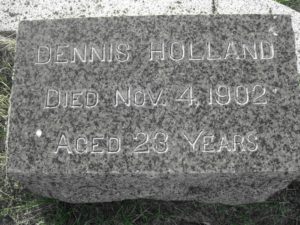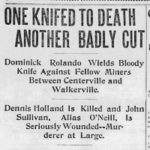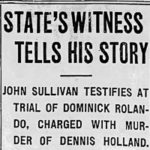
I believe that we are all impacted and shaped by the experiences that our parents, grandparents, and great-grandparents endured. Every event that each generation went through formed our view of society, our ability to trust and our respect for authority. I think that especially the stories that we don’t know about are the most valuable. When we discover them, they help us understand and build compassion for our parents and grandparents, it helps us understand why they were the way they were. It also helps us develop an understanding of the responses that we have in any given situation and what we do or do not pass on to our children.
This is another family story that I discovered on my own. I found it while searching around in an online historic newspaper archive. At first, I thought that the story was about my great grandfather Dominick Rolando but then realized that it couldn’t have been him because the Dominick in the articles was too young and he had a wife living in Italy. Only after digging into the family in Cintano, I realized that the Dominick in this story was a cousin from Cintano and was even more closely related to my family when his son married my grandmother’s sister Lorraine. I collected these articles and shared them with a few family members but was not sure how to approach this story.
Following is a description of the events that I have reconstructed from the newspapers and the formal inquest. You will get the most from this story by reading the articles, they are organized below by paper and date. Click on each headline to read the story, and hit the back button to return to read the next. Each newspaper takes a different spin on the story, some are very sensationalized and inflammatory while others just deal with the facts.
The picture at the top of this post shows where the murder took place. The head frame in the middle left of the picture is the Lexington Mine, the stabbing occurred somewhere near the building on the far-left side. The Mountain Con mine is the head frame on the far right of the picture and the St. Lawrence church where they took the body, and the funeral was held, is in the center of the picture. The murder took place in November, so there very well could have been a skiff of snow just like in the photograph.
As I said before the Dominick Rolando in the articles was a cousin of the Rolando brothers that came from Cintano, he was mentioned in the previous post “Rolando Men.” The picture of the Rolando men must have been taken some time in 1902 or early 1903. Dominick was born in Cintano Italy, on January 10, 1879, to Giuseppe Zucco-Rolando and Maria Bona Lisa. According to the 1945 South Dakota census, Dominick arrived in the United States in 1901. Family rumor has it that he came to the US after working in the mines of South America and Mexico. I did try to find his immigration records but didn’t have any luck.
He was naturalized in Butte on October 20, 1902. The naturalization papers state his name as Dominick Rolendo, but the document was witnessed by Great-Aunt Theresa’s husband, Antone Chimonotto, so I do believe that they belong to our Dominick.
This story portrays the dirty side of the richest hill on earth and showcases the ethnic pride and animosity that existed in the neighborhoods. In this story, there is one victim and one hero, and they are the same man, Dominick Rolando.
November 5, 1903
Dominick Rolando stabbed Dennis Holland to death and seriously wounded John Sullivan near the Lexington Mine between Centerville and Walkerville. There were no witnesses to the murder, Sullivan and Cousin Dominick told conflicting accounts.
Sullivan and Holland were popular members of the Irish community in Centerville, they lived at 148 East Center Street and 117 East Center Street respectively. Dominick was a well-known member of the Italian community of Walkerville. At this time his cousins John and Joseph Rolando and TonyChiuminatti were living in a boarding house at 104 East Dayly Street, and his friend James Valenzano was residing at 204 West Dayly. Great-grandfather Dominick and his family were living on East Park. Grandma Mary would have been nearly two years old, and her living sibling at the time was James (6 years old). Great-grandpa Dominick worked as a miner in the Pennsylvania mine.
Cousin Dominick had been working at the Mountain Consolidated Mine, but it had been temporarily shut down so, on Thursday, November 5, he went to the mine to collect his pay, totaling $35 (worth about $1,000 today). His next stop was Hennessy’s to purchased two blankets and he was making his way home to Walkerville when he stopped at the Topic Saloon at the corner of Main and Center Street around 4 pm. Dominick had a beer and won 80 cents in the slot machine, to celebrate his good luck he bought the two men in the saloon (Sullivan and Holland) a drink. He won another 80 cents and bought another round, after that Holland ordered another round and Dominick paid. After the third round, Dominick left the bar to go home to Walkerville, this is where the two stories begin to differ.
Sullivan’s version “We walked along together until we got near the old cable trestle. Here we stopped, and I told Dennis that we would better not go over there with the Dago. I hadn’t any money to spend and didn’t want to go. I hadn’t spoken but a few words to Dennis when the first thing I know I got stabbed in the arm. I turned, and the Italian slashed me in the ribs with the knife. I started to run then, and before I could get away, he stuck me in the back.” “I got about 15 feet from him when I heard Holland holler ‘Come back Jack, I am stuck!’”. When asked why Dominick stabbed them Sullivan responded: “I don’t know any reason.”
Dominick’s side of the story gave more motive for the murder. He only spoke English brokenly but told deputy sheriff Caldisero the details in Italian after he was taken to the county jail. As they walked up to Walkerville, Sullivan was walking in front of Dominick and Holland behind. When they reached a dark spot near the Lexington Mill, he was suddenly attacked by both men simultaneously and thrown to the ground. Holland holding him down and Sullivan going through his pockets. Before they found his money, Dominick managed to get his knife out to defend himself.
After the murder, Dominick ran to Walkerville where he met his friend Jim Valenzano. Dominick wanted to give himself up to the police but was dissuaded by members of the Italian community, who whisked him away into hiding.
The murder weapon was Dominick’s pocket knife, described as either a stiletto or a 4″ rusty pocket knife, depending on the newspaper. The wound that caused the death of Holland was a deep incision in the left thigh, that severed the femoral artery, causing him to bleed to death. After the encounter, Sullivan ran back to the Topic Saloon to get help. Several men returned to the scene and found Holland on the ground bleeding. The men carried him to the priest’s house near the St. Lawrence Church, but he died before he was taken inside.
By this time the story of the murder had reached the Irish community of Centerville, men met at the Topic Saloon, and a search for Dominick independent of the Sheriff began. A mob of about 250 men armed with a rope went to find Dominick. The search was futile as the Italian community had concealed him so well and most citizens of Walkerville denied even knowing Dominick at all. Later in the evening word came from the Italian quarter of Walkerville that Dominick would give himself up as soon as the lynch mob had quieted.
November 6, 1903
At 5 am the next morning, Dominick, dressed as if he were any other miner heading for work, with a lunch pail and all, walked into the City Jail and surrendered to the janitor, Mike Hurley. Dominick gave his name and surrendered the murder weapon, his pocket knife. He was then taken to the county jail. A number of the Italian community came to speak with him and urged him to remain silent, and a lawyer, J.L. Wines was retained for him.
As all of this was going on, Jim Valenzano was arrested for aiding him in evading arrest but was released soon after. Headlines in the Butte Daily Post stated: “Italians Flocking to visit Rolando.” “Rolando’s case has excited the Italians of Butte and the suburban places of Meaderville, Centerville, and Walkerville in excess of anything that has occurred for a long time.” The Butte Miner stated, “He was visited by a throng of Italians, many of whom were women, and all talked excitedly in their mother tongue.” The Butte Daily Post reported, “Many of Rolando’s friends are women, most of them young, and they usually departed from the jail weeping after their visits to him.”
That evening the inquest into the murder was held at Duggan’s Funeral home. The people at the Butte Archives found the original inquest, you can see it below. A large crowd gathered to watch the inquest, and it was apparent that the Sheriff expected trouble, as he brought a “full force of deputies” to protect Dominick. The jury at the inquest brought the following verdict. “That the said Dennis Holland came to his death at Centerville, Silver Bow County, Montana, from a knife wound in the leg, inflicted by Dominick Rolando on November 4, 1903”.
The Inquest document portrays the ethnic bias present in Butte during that time in history. While the different ethnicities worked side by side in the mines, there were clear definitions of status and attitudes to each other. In the entire inquest document, Dominick is never once mentioned by his name, he is only referred to as “the Dago.” No one from the Italian community was interviewed at the inquest, and all of the witnesses had Irish names, and most were from Centerville. Even the doctors that examined Holland were Dr. O’Leary and Dr. McCarthy.
November 7, 1903
Dennis Holland’s funeral was held at his family home at 117 East Center Street in Centerville. The services were held at St. Lawrence Church, and he was buried at the Holy Cross Cemetery. Most of the Centerville community turned out to mourn him.
February 4, 1904
On February 4th the trial began. The court had a difficult time finding impartial jurors, as most had read the articles in the local papers and had already formed an opinion on his guilt or innocence.
February 6, 1904
Dominick was acquitted of murder charges after a brief twenty-five minutes of deliberation by the jury. The jury believed that Sullivan, who was the only witness, relayed an inconsistent account of the murder. The verdict was read, and Dominick was released. According to the Butte Miner, there were nearly one hundred supporters of Rolando in the court room.
As Dominick and his supporters were leaving the court room Judge McClernan suggested that the county attorney investigate Sullivan on the charges of attempted robbery. A warrant was issued, and Sullivan was arrested.
February 19, 1904
John Sullivan was released on February 19 because of a lack of evidence.
Dominick’s obituary states that he lived in Butte, Arizona, Trojan, and settled in Lead South Dakota in 1923. His wife was Margherita Chiono. Margherita was born March 17, 1882, in Sale, Italy and they were married in Cintano December 9, 1900. One of the articles says that Dominick had a wife and child living in Italy, but I can find no record of that child. Their first child was born in 1908, so his wife had joined him in South Dakota sometime before that. Dominick and Margaret had seven children.
Our family is so lucky that the Italian community hid him away so quickly and completely that night in November.
Articles from The Butte Daily Post
Articles from The Anaconda Standard
Articles from The Butte Miner
Articles from The Great Falls Tribune



























